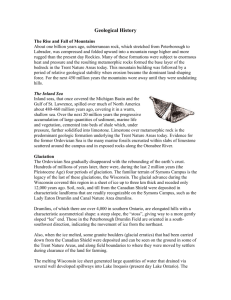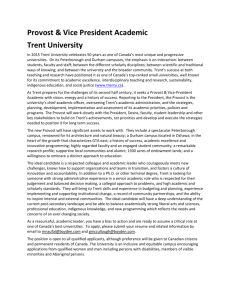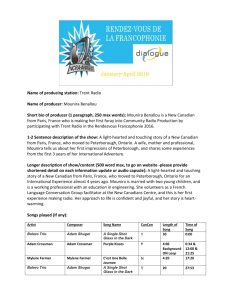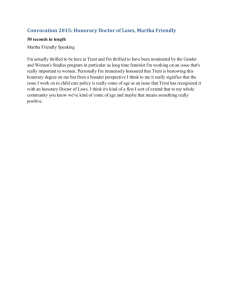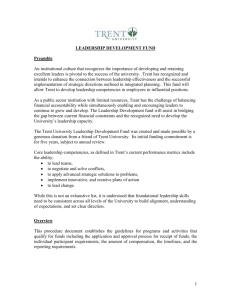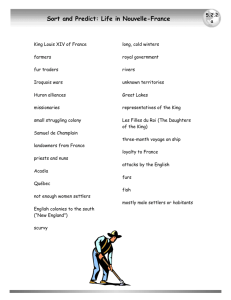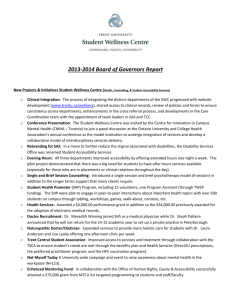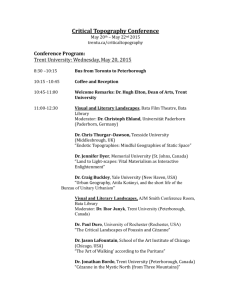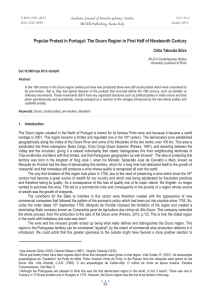Cultural History - Trent University
advertisement
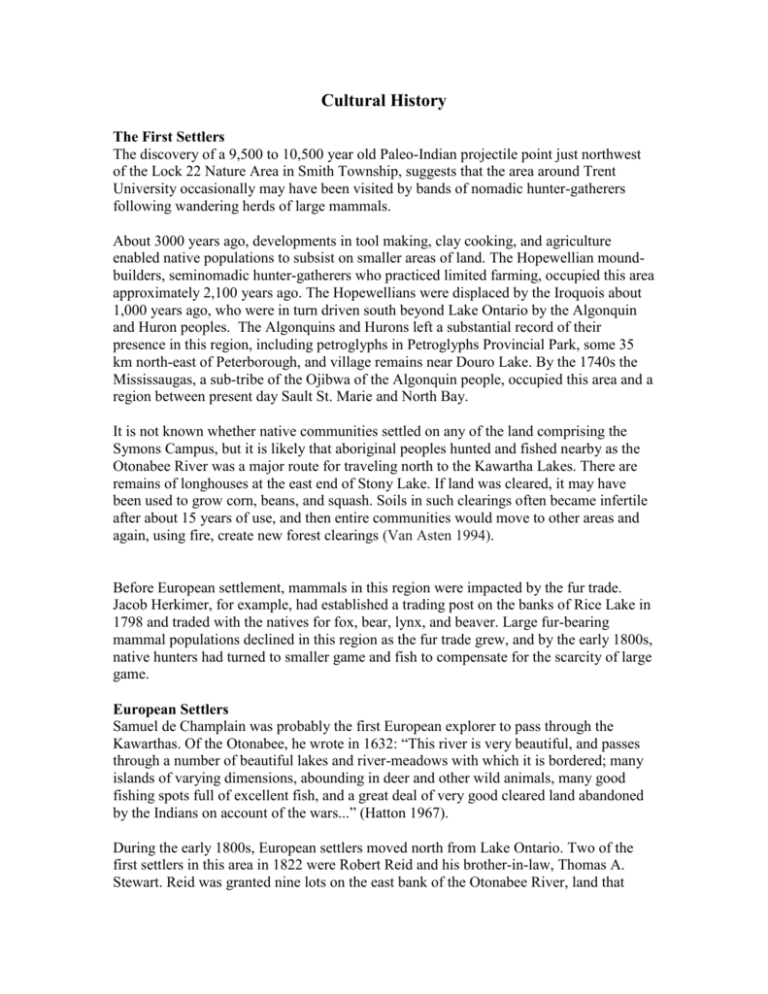
Cultural History The First Settlers The discovery of a 9,500 to 10,500 year old Paleo-Indian projectile point just northwest of the Lock 22 Nature Area in Smith Township, suggests that the area around Trent University occasionally may have been visited by bands of nomadic hunter-gatherers following wandering herds of large mammals. About 3000 years ago, developments in tool making, clay cooking, and agriculture enabled native populations to subsist on smaller areas of land. The Hopewellian moundbuilders, seminomadic hunter-gatherers who practiced limited farming, occupied this area approximately 2,100 years ago. The Hopewellians were displaced by the Iroquois about 1,000 years ago, who were in turn driven south beyond Lake Ontario by the Algonquin and Huron peoples. The Algonquins and Hurons left a substantial record of their presence in this region, including petroglyphs in Petroglyphs Provincial Park, some 35 km north-east of Peterborough, and village remains near Douro Lake. By the 1740s the Mississaugas, a sub-tribe of the Ojibwa of the Algonquin people, occupied this area and a region between present day Sault St. Marie and North Bay. It is not known whether native communities settled on any of the land comprising the Symons Campus, but it is likely that aboriginal peoples hunted and fished nearby as the Otonabee River was a major route for traveling north to the Kawartha Lakes. There are remains of longhouses at the east end of Stony Lake. If land was cleared, it may have been used to grow corn, beans, and squash. Soils in such clearings often became infertile after about 15 years of use, and then entire communities would move to other areas and again, using fire, create new forest clearings (Van Asten 1994). Before European settlement, mammals in this region were impacted by the fur trade. Jacob Herkimer, for example, had established a trading post on the banks of Rice Lake in 1798 and traded with the natives for fox, bear, lynx, and beaver. Large fur-bearing mammal populations declined in this region as the fur trade grew, and by the early 1800s, native hunters had turned to smaller game and fish to compensate for the scarcity of large game. European Settlers Samuel de Champlain was probably the first European explorer to pass through the Kawarthas. Of the Otonabee, he wrote in 1632: “This river is very beautiful, and passes through a number of beautiful lakes and river-meadows with which it is bordered; many islands of varying dimensions, abounding in deer and other wild animals, many good fishing spots full of excellent fish, and a great deal of very good cleared land abandoned by the Indians on account of the wars...” (Hatton 1967). During the early 1800s, European settlers moved north from Lake Ontario. Two of the first settlers in this area in 1822 were Robert Reid and his brother-in-law, Thomas A. Stewart. Reid was granted nine lots on the east bank of the Otonabee River, land that included 6 of the 12 designated Trent Nature Areas, and Stewart settled on seven lots of land just south of Symons Campus. On the west bank of the Otonabee, John Smith was granted lot 21 of Concessions 3 and 4 (4 of the 12 designated Trent Nature Areas), as payment for surveying parts of Smith and Douro Townships. More settlers arrived shortly thereafter, encouraged by William Horton, who wanted to send impoverished Irish farmers to Upper Canada at the expense of the British. Peter Robinson was appointed to oversee the immigration of over 2000 settlers to Scott’s Plains (now Peterborough). In return for land grants, settlers were required to clear five out of every 100 acres of bush, construct a log shanty, and clear a section of road. (Theberge & Theberge 1982). Lumbering Lumbering served local needs in the early 1840s, when logs were being processed at several mills in Peterborough. Charles Perry began purchasing land around Nassau in 1851, and by 1854 had constructed the Nassau Mill, the largest sawmill in the Peterborough region, on the site of Trent’s present hydroelectric facility (Jones & Dyer 1987). The settlement of Douro and Smith townships (Trent University straddles both) involved the rapid clearing of the forested landscape for agriculture. The fertile soils of the southern portions of both townships encouraged settlement, and in only 56 years most of Smith and Douro had been cleared of trees. A rail line extending from Port Hope to Peterborough facilitated lumber production. Peterborough County produced over 50 million board feet of lumber, 10 million of which came from the Nassau Mill. The demand for lumber came mostly from the British market and was for squared timber (usually red or white pine) for use in shipbuilding and as beams for construction purposes. Trees were planted as well as felled. Some evidence of a tree planting initiative established in 1883 may still be seen in and around Trent’s Nature Areas. A provincial Act encouraged farmers to plant trees (walnut, ash, elm, maple, oak, pine, and hickory) by providing them 25 cents for each tree planted in the vicinity of property boundaries, roads, and highways. Farming Cultivation of crops on the Symon’s Campus was occurring in the early 1830s. Township Assessment Rolls, for example, indicate that Robert Reid had 120 of his 1,080 acres under cultivation, some of which were likely in the present day Wildlife Sanctuary Nature Area. By 1840, George Cunningham had cleared one half of the area around the Otonabee College Wetland and Archaeology Centre Wetland TNAs. John Smith cleared the west bank around 1826 and cultivated 14 acres (5.5 ha) in the Total Loss Farm NA (Jamieson 1989). The mechanization of farming practices in the late 19th and early 20th centuries intensified land use. Tractors replaced horses, and farmers turned to dairy production, meat cattle, and poultry, as well as wheat, barley, oat, and corn production. Lime and phosphate fertilizers were applied to increase yields and were later replaced by inorganic fertilizers and pesticides (Van Asten 1994). Mixed farming, including orchards, fall and winter wheat, dairy and meat cattle, and oats, occurred by the end of the 19th century (Van Asten 1994) on land now in the Wildlife Sanctuary Nature Area. Reference: Jones, R., M.G. Fox and J. S. Marsh. 2002. Draft- The Stewardship Plan for Trent University Nature Areas. Trent University, Peterborough, Ontario. This document is available from the Trent University Bata Library.

